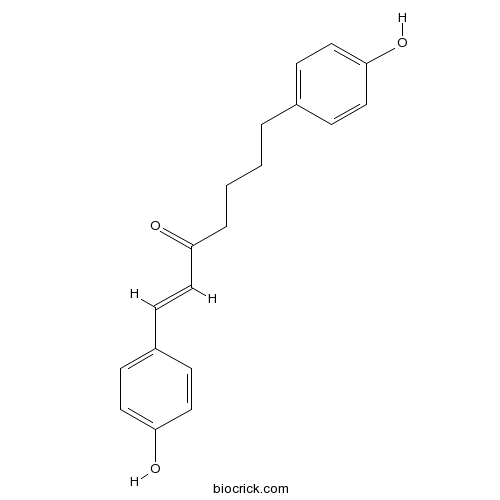1,7-Bis(4-hydroxyphenyl)hept-1-en-3-oneCAS# 1083200-79-6 |

Quality Control & MSDS
3D structure
Package In Stock
Number of papers citing our products

| Cas No. | 1083200-79-6 | SDF | Download SDF |
| PubChem ID | 38361084 | Appearance | Yellow powder |
| Formula | C19H20O3 | M.Wt | 296.4 |
| Type of Compound | Phenols | Storage | Desiccate at -20°C |
| Solubility | Soluble in Chloroform,Dichloromethane,Ethyl Acetate,DMSO,Acetone,etc. | ||
| Chemical Name | (E)-1,7-bis(4-hydroxyphenyl)hept-1-en-3-one | ||
| SMILES | C1=CC(=CC=C1CCCCC(=O)C=CC2=CC=C(C=C2)O)O | ||
| Standard InChIKey | IHZRLGRBBLFVBQ-JXMROGBWSA-N | ||
| Standard InChI | InChI=1S/C19H20O3/c20-17(10-7-16-8-13-19(22)14-9-16)4-2-1-3-15-5-11-18(21)12-6-15/h5-14,21-22H,1-4H2/b10-7+ | ||
| General tips | For obtaining a higher solubility , please warm the tube at 37 ℃ and shake it in the ultrasonic bath for a while.Stock solution can be stored below -20℃ for several months. We recommend that you prepare and use the solution on the same day. However, if the test schedule requires, the stock solutions can be prepared in advance, and the stock solution must be sealed and stored below -20℃. In general, the stock solution can be kept for several months. Before use, we recommend that you leave the vial at room temperature for at least an hour before opening it. |
||
| About Packaging | 1. The packaging of the product may be reversed during transportation, cause the high purity compounds to adhere to the neck or cap of the vial.Take the vail out of its packaging and shake gently until the compounds fall to the bottom of the vial. 2. For liquid products, please centrifuge at 500xg to gather the liquid to the bottom of the vial. 3. Try to avoid loss or contamination during the experiment. |
||
| Shipping Condition | Packaging according to customer requirements(5mg, 10mg, 20mg and more). Ship via FedEx, DHL, UPS, EMS or other couriers with RT, or blue ice upon request. | ||

1,7-Bis(4-hydroxyphenyl)hept-1-en-3-one Dilution Calculator

1,7-Bis(4-hydroxyphenyl)hept-1-en-3-one Molarity Calculator
| 1 mg | 5 mg | 10 mg | 20 mg | 25 mg | |
| 1 mM | 3.3738 mL | 16.8691 mL | 33.7382 mL | 67.4764 mL | 84.3455 mL |
| 5 mM | 0.6748 mL | 3.3738 mL | 6.7476 mL | 13.4953 mL | 16.8691 mL |
| 10 mM | 0.3374 mL | 1.6869 mL | 3.3738 mL | 6.7476 mL | 8.4345 mL |
| 50 mM | 0.0675 mL | 0.3374 mL | 0.6748 mL | 1.3495 mL | 1.6869 mL |
| 100 mM | 0.0337 mL | 0.1687 mL | 0.3374 mL | 0.6748 mL | 0.8435 mL |
| * Note: If you are in the process of experiment, it's necessary to make the dilution ratios of the samples. The dilution data above is only for reference. Normally, it's can get a better solubility within lower of Concentrations. | |||||

Calcutta University

University of Minnesota

University of Maryland School of Medicine

University of Illinois at Chicago

The Ohio State University

University of Zurich

Harvard University

Colorado State University

Auburn University

Yale University

Worcester Polytechnic Institute

Washington State University

Stanford University

University of Leipzig

Universidade da Beira Interior

The Institute of Cancer Research

Heidelberg University

University of Amsterdam

University of Auckland

TsingHua University

The University of Michigan

Miami University

DRURY University

Jilin University

Fudan University

Wuhan University

Sun Yat-sen University

Universite de Paris

Deemed University

Auckland University

The University of Tokyo

Korea University
- 1,7-Bis(4-hydroxyphenyl)hept-6-en-3-ol
Catalog No.:BCN1630
CAS No.:1083195-05-4
- Cariprazine hydrochloride
Catalog No.:BCC1454
CAS No.:1083076-69-0
- A 987306
Catalog No.:BCC7732
CAS No.:1082954-71-9
- LY2584702
Catalog No.:BCC6369
CAS No.:1082949-67-4
- PF-04447943
Catalog No.:BCC1850
CAS No.:1082744-20-4
- PDE-9 inhibitor
Catalog No.:BCC1842
CAS No.:1082743-70-1
- TC-S 7005
Catalog No.:BCC6189
CAS No.:1082739-92-1
- TUG 424
Catalog No.:BCC7776
CAS No.:1082058-99-8
- SKF 83566 hydrobromide
Catalog No.:BCC7121
CAS No.:108179-91-5
- 6-(beta-D-glucopyranosyloxy)-Salicylic acid methyl ester
Catalog No.:BCN1631
CAS No.:108124-75-0
- α-Terthiophene
Catalog No.:BCN8380
CAS No.:1081-34-1
- KT 5720
Catalog No.:BCC8080
CAS No.:108068-98-0
- Fmoc-D-Asn-OH
Catalog No.:BCC3083
CAS No.:108321-39-7
- Geneticin, G-418 Sulfate
Catalog No.:BCC1202
CAS No.:108321-42-2
- Ganoderic acid D
Catalog No.:BCN2437
CAS No.:108340-60-9
- Noradrenaline bitartrate monohydrate
Catalog No.:BCC4810
CAS No.:108341-18-0
- Fuligorubin A
Catalog No.:BCN1837
CAS No.:108343-55-1
- FH535
Catalog No.:BCC1573
CAS No.:108409-83-2
- [D-Phe12]-Bombesin
Catalog No.:BCC5844
CAS No.:108437-87-2
- [D-Phe12,Leu14]-Bombesin
Catalog No.:BCC6020
CAS No.:108437-88-3
- Ilexsaponin A
Catalog No.:BCN7867
CAS No.:108524-93-2
- Ilexgenin A
Catalog No.:BCC9233
CAS No.:108524-94-3
- Eupahualin C
Catalog No.:BCN7234
CAS No.:108525-39-9
- 23S-hydroxy-11,15-dioxo-ganoderic acid DM
Catalog No.:BCN8131
CAS No.:1085273-49-9
Synthesis of natural and non-natural curcuminoids and their neuroprotective activity against glutamate-induced oxidative stress in HT-22 cells.[Pubmed:25313922]
J Nat Prod. 2014 Oct 24;77(10):2206-17.
A strategy for the synthesis of natural and non-natural 5-deoxy-6,7-dihydrocurcuminoids (diarylheptanoids) was developed for the preparation of 14 compounds with varying aromatic substituent patterns and a different functionality in the aliphatic seven-carbon chain. The in vitro protective activity against glutamate-induced neuronal cell death was examined in the murine hippocampal cell line HT-22 to find structural motifs responsible for neuroprotective effects in vitro. Among the tested compounds the ferulic acid-like unit, present in the structures of (E)-1,7-bis(4-hydroxy-3-methoxyphenyl)hept-1-en-3-one (5) and (E)-1-(4-hydroxy-3-methoxyphenyl)-7-(4-hydroxyphenyl)hept-1-en-3-one (7), appeared to be an important feature for protection against glutamate-induced neurotoxicity. Both compounds demonstrated significant neuroprotective activity in a concentration range between 1 and 25 muM without showing toxic effects in a cytotoxicity assay with HT-22 cells. Furthermore, (E)-1,7-bis(3,4-dihydroxyphenyl)hept-1-en-3-one (9), exhibiting a caffeic acid-like structural motif, displayed a neuroprotective activity at a nontoxic concentration of 25 muM. In contrast, (1E,6E)-1,7-bis(3,4-dihydroxyphenyl)hepta-1,6-diene-3,5-dione (4, di-O-demethylcurcumin) showed mainly cytotoxic effects. A corresponding single-ring analogue that contains the ferulic acid-like unit as an enone was not active.


